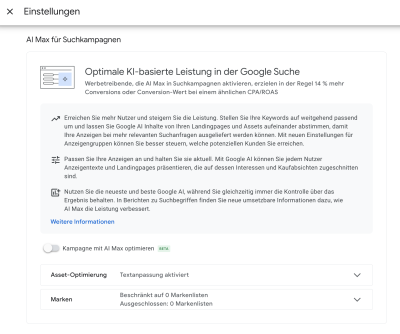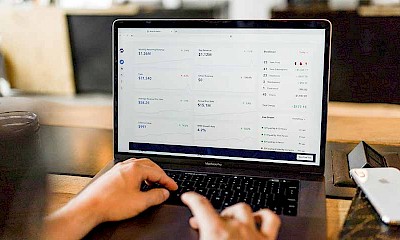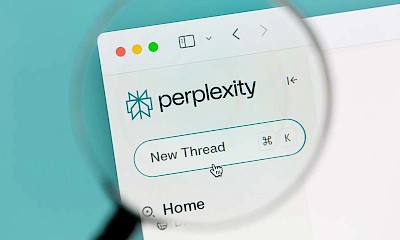Choose an existing search campaign with stable performance.

Google AI Max - The new AI upgrade for search campaigns
Google search is changing: users are now making more complex, dialog-oriented and long-tail search queries and expect precise, helpful answers. At the same time, Google is consistently developing its advertising solutions in the direction of automation and AI. With AI Max, Google is now presenting a new campaign upgrade for search campaigns that combines these two developments.
The most important things at a glance:
The user experience in Google Search is changing fundamentally: AI-supported overviews, visual results and multimodal searches (e.g. via Google Lens) are leading to more explorative and conversational search processes.
AI Max is an optional AI upgrade for existing search campaigns that adds context-based, automated targeting to keywords. It recognizes user intent even for complex, long-tail search queries and creates dynamic ad texts and target page assignments in real time.
AI Max combines Broad Match with user signals such as remarketing data (if activated & configured), conversion history and device types in order to display relevant ads proactively - even for keywords that have not been explicitly booked.
For optimal use, a structured test approach with clear goals, clean tracking, optimized landing pages and ongoing monitoring is recommended. AI Max does not replace campaign management, but shifts the focus towards strategic control and data-based fine-tuning.
How is the user experience in Google Search changing?
Instead of the usual Google search results, users receive more varied, visual and AI-summarized results. They see a pre-filtered AI summary, the so-called AI Overview, for suitable search queries. Sources can still be accessed individually if required. This is particularly helpful for complex or ambiguous questions. The AI Overview is now usually displayed above the organic search results and paid ads. The integration of Google Lens, the smart image search, is also becoming a natural part of the search experience. This not only enables faster information processing, but also a conversational search. Users can ask questions and engage in further dialog with the search. The goal is a Google search that works like an AI-supported search partner.
AI unleashes the full potential of Google Search as it becomes more exploratory and multimodal.
What does this mean for Google Ads?
With the changes, the importance of automation in performance marketing is also growing. In addition to previous smart campaign formats and bidding strategies, Google has now added the new AI Max feature to its search campaigns. Google is positioning AI Max as a central element of the transformation to an AI-driven Google search. The aim is to unleash the full power of search - more exploratory, multimodal and predictive.
What is Google AI Max?
AI Max is an optional, AI-supported upgrade for existing Google search campaigns. It is Google's response to the shift towards morenatural language and morecomplexsearch queries. Unlike Performance Max, AI Max is aimed exclusively at the search network - and works as an add-on for existing search campaigns. It is activated via opt-in in the settings of the respective search campaign.
It does not mean the end of keywords, but extends pure keyword control. Keywords remain relevant, but AI supplements them with context and long-tail queries. The new feature automatically extends the campaign reach to relevant search terms. This makes ad delivery more proactive, as AI recognizes user intentions - even if the keyword is not exactly matched.

Gaining a competitive edge with AI
Take advantage of the new possibilities of Google Ads! We support you in the strategic integration of AI Max into your campaign structure and accompany you with data-based performance monitoring. Arrange a non-binding consultation now and take your Google Ads to the next level.
How AI Max works
Search term matching
AI Max brings a new way of thinking to search engine marketing: instead of focusing purely on keywords, the AI understands the thematic context of ads, landing pages and user queries. The AI analyses website content, existing ad texts and keyword topics to identify user queries. This opens up new, relevant search queries. The campaign can appear for suitable search queries, even if the corresponding keywords have not been entered manually.
Example: You advertise "desks for the home office", but a user searches for "back-friendly workplace" - AI Max recognizes the relevance and shows your ad anyway.
Smart display through broad match and signals
The AI also uses signals from broad match keywords combined with conversion data, remarketing signals and device types to deliver the right ad at the right time.
Google calls this system "keywordless matching" because the AI not only understands the keywords entered, but also interprets their meaning and intent.
Dynamic ad texts
AI Max automatically creates ad titles and descriptions in real time, tailored to user intent, landing page and previous ad performance. This creates a customized ad for each user without you having to create countless variants.
Intelligent landing page selection
The AI ensures that the user is directed to the most suitable landing page - even without manual URL mapping. However, you can specifically exclude URLs, for example for legally sensitive content or restricted offers.
Control options for advertisers
Despite the high level of automation, AI Max is not a black box system. These control options are still available:
- Set locations, language, budget and bids
- Protect brand keywords
- Exclude certain landing pages
- Set negative keywords
- Perform A/B tests with Google Ads drafts and experiments
- Analyze reports on search terms, asset performance and landing pages
Existing reports are expanded to include search terms with associated headlines and URLs in the reports, which are given the new "AI Max" match type label. In addition, the performance of automatically created assets can be analyzed based on costs &
Google Tutorial: AI Max for Search Campaigns
Potential of AI Max compared to traditional search campaigns
The use of the AI Max feature compared to traditional search campaigns offers potential for a performance boost through the expansion of reach, broader semantic coverage of the keyword selection and target page relevance. Initial Google beta results already show positive developments.
AI Max reaches search queries that your campaign's keywords would otherwise not cover. The AI recognizes thematic connections, user intentions and semantic variants.
On average, Google reports up to +14% more conversions with the same CPA or a 14% higher conversion value with the same ROAS. (Source: Google)
The control of budget, bids, location targeting, brand control, URL exclusions and negative keywords remains in place.
Reports show new search terms with AI Max labeling, asset performance and landing page usage. A/B tests are also possible.
AI Max thus opens up new opportunities - especially for accounts where:
- volume is stagnating but there is untapped potential in long-tail keywords,
- the keyword setup is reaching its limits (e.g. many semantic variants) or
- ad creation is time-consuming.
Best Practices for AI Max Campaigns
Although Google AI Max comes with a lot of automation, this does not mean that advertisers can simply leave everything to AI. On the contrary: those who think along, control and test in a structured way will achieve better results. As with all automation, there are also pitfalls with AI Max:
- The level of control is more difficult to predict - especially for new products.
- Brand exclusions are necessary for a clean evaluation.
- The quality of your landing pages is crucial: if content is vague or not presented in a targeted manner, performance will suffer.
You should pay attention to the following best practices so that AI Max can be used strategically and wisely.
Perhaps the most important success factor when using AI Max is precise and clean conversion tracking. Artificial intelligence can only optimize effectively if it knows what it is working towards. Conversion actions - such as purchases, completed contact forms or newsletter registrations - should therefore be set up properly in Google Ads and marked as primary target actions. The database should be reliable, ideally through integration with Google Tag Manager or Google Analytics 4 (GA4). If errors occur here or important interactions are not recorded at all, the AI works with the wrong assumptions and wastes a lot of potential.
Another important aspect of AI Max is the role of the landing pages. The AI analyzes your website content to generate relevant ad content and identify suitable search queries. This makes it all the more important that your landing pages are clearly structured, mobile-optimized and easy to understand. Content should focus on a specific topic and be supported by clear headlines, call-to-actions and keyword signals. Technical factors such as loading time and accessibility also play a role. Ultimately, the better your site is structured, the more targeted and conversion-boosting AI Max can work.
Despite all the automation, regular monitoring remains a central component of successful campaign management. The search term report allows you to quickly see which terms your ads were delivered for - often including many long-tail variants that you might not have thought of. It's worth taking a closer look here:
- Are the search queries relevant?
- Are there exclusion terms that could minimize wastage?
At the same time, the reports on assets and target pages can be used to draw conclusions about which texts and content perform particularly well. This allows you to continuously improve the quality of your website and your offer - tailored to real search intentions.
A particularly important point concerns the control of your brand terms. AI Max recognizes potentially relevant queries even if they contain your brand - but this can distort your budget and make it more difficult to control your brand traffic. If you want to protect yourself here, you should continue to run your brand keywords in a separate campaign. AI Max can then be used specifically for generic terms.
The introduction of new features such as AI Max should never be done at random. Instead, it is advisable to first evaluate the feature in a structured A/B test. Ideally, you should choose a campaign with a stable history in order to obtain valid comparative values. Plan a minimum duration in line with your budget and the amount of data that can be evaluated - this is the only way to sort out short-term fluctuations and identify reliable trends. Then compare the key performance indicators:
- Has AI Max outperformed previous performance?
- Where are CPA or ROAS?
- What new search terms or ad variants have emerged?
Last but not least, it is important to see AI Max not as a replacement, but as an assistant. The AI can do a lot, but not everything. Those who provide it with the right signals will benefit significantly more. This includes clean page structures, clear target definitions and targeted exclusions. At the same time, the AI should also be given enough freedom to learn. Restrictions that are too tight - such as too many negative keywords or target groups that are too strict - can limit its effectiveness. Instead of giving up control completely or trying to block everything, it makes more sense to consciously steer the AI - with a balance of freedom and strategic guidance.
How to get started with AI Max
Activate AI Max as an A/B test in Google Ads subject to the best practices mentioned.
Monitor KPIs such as conversions, new search terms and asset performance.
Carry out the performance validation after a meaningful period of time.
Decide on the basis of the KPIs whether the rollout to other campaigns makes sense.

Do you always want to benefit from the latest Google Ads features?
Use the full potential of Google Ads - with a strategy that combines AI-supported innovation and the expertise of an experienced SEA agency. We help you to use technologies such as AI Max in a targeted manner and make your campaigns measurably more successful. We look forward to getting to know you in a no-obligation initial consultation!
Conclusion
AI Max brings smart AI features such as keyword matching, asset optimization and URL extension to classic search campaigns. At the same time, it does not mean the end of keywords - it supplements, expands and optimizes them with the help of AI. Google AI Max is no substitute for good campaign management - but it is a powerful tool for scaling reach, relevance and performance with AI.
Our recommendation: test AI Max in a structured way, use the control functions and benefit from the head start in an increasingly automated ads world.











